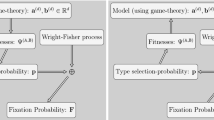Abstract
It is shown that in the classical model of population genetics (Fisher-Wright-Haldane, discrete or continuous version) every solution p(t) converges to equilibrium for t → ∞. For related models of evolutionary games (with non-symmetric matrices) it is shown that the transformation that describes the dynamics is a diffeomorphism (in particular one-to-one).
Similar content being viewed by others
References
Akin, E.: The metric theory of banach manifolds. Lecture notes in mathematics, vol. 622. Berlin- Heidelberg-New York: Springer 1978
Akin, E.: The geometry of population genetics. Lecture notes in biomathematics, vol. 31. Berlin- Heidelberg-New York: Springer 1979
Akin, E., Hofbauer, J.: Recurrence of the unfit. Math. Biosci. (to appear) (1982)
Ginzburg, L. R.: Diversity of fitness and generalized fitness. J. Gen. Biol. 33, 77–81 (1972)
an der Heiden, U.: On manifolds of equilibria in the selection model for multiple alleles. J. Math. Biol. 1, 321–330 (1975)
Hines, W. G. S.: Three characterizations of population strategy stability. J. Appl. Prob. 17, 333–340 (1980)
Karlin, S.: A first course in stochastic processes. New York: Academic Press 1966
Karlin, S., Feldman, M. W.: Linkage and selection: Two locus symmetric viability model. J. Theoret. Population Biology 1, 39–71 (1970)
Kingman, J. F. C.: A mathematical problem in population genetics. Proc. Camb. Phil. Soc. 57, 574–582 (1961)
Lang, S.: Differential manifolds. Reading, Mass.: Addison-Wesley 1972
May, R. M.: Biological populations with nonoverlapping generations: Stable points, stable cycles, and chaos. Science 186, 645–647 (1974)
Mulholland, H. P., Smith, C. A. B.: An inequality arising in genetical theory. Am. Math. Mon. 66, 673–683 (1959)
Scheuer, P. A. G., Mandel, S. P. H.: An inequality in population genetics. Heredity 13, 519–524 (1959)
Taylor, P., Jonker, L.: Evolutionarily stable strategies and game dynamics. Math. Biosci. 40, 145–156 (1978)
Feller, W.: A geometrical analysis of fitness in triply allelic systems. Math. Biosci. 5, 19–38 (1969).
Author information
Authors and Affiliations
Additional information
The authors would like to thank Dr. Josef Hofbauer for useful discussions about this work
Rights and permissions
About this article
Cite this article
Losert, V., Akin, E. Dynamics of games and genes: Discrete versus continuous time. J. Math. Biology 17, 241–251 (1983). https://doi.org/10.1007/BF00305762
Revised:
Issue Date:
DOI: https://doi.org/10.1007/BF00305762




